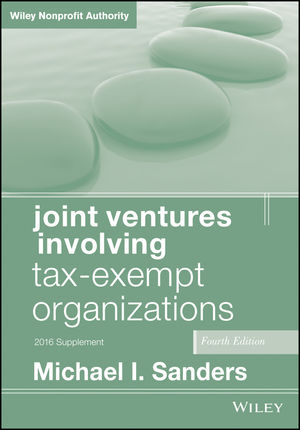
Joint Ventures Involving Tax–Exempt Organizations
John Wiley & Sons Inc (Verlag)
978-1-118-92848-6 (ISBN)
- Titel ist leider vergriffen;
keine Neuauflage - Artikel merken
For-profit strategy for the nonprofit world Joint Ventures Involving Tax-Exempt Organizations provides a detailed examination of the laws, rules, and regulations governing partnerships and joint ventures, with an emphasis on maintaining exempt status. This comprehensive guide has been completely revised and expanded to reflect the most recent legislation, providing readers with a complete, single-volume reference including interpretation and practical guidance. Sample documents allow for easy quick reference, and give readers the opportunity to see how the new laws are applied in real-world scenarios. Readers will learn how careful planning can engage the support of nonprofit and for-profit businesses without threatening an organization's tax-exempt status, and which joint ventures are more likely to produce the desired results for their particular organization. Joint ventures, partnerships, and alliances, long accepted as good business strategy in the for-profit world, are increasingly being adopted by nonprofits seeking creative means of financing in these difficult economic times.
This book is a guide to properly planning and structuring these ventures to the utmost benefit of all entities involved, while maintaining compliance with tax-exemption qualifications. * Review the taxation of charitable organization, partnerships, and joint ventures * Discover which transactions are best suited to which organizations * Learn the different joint venture configurations available to tax-exempt organizations, such as new market tax credit financing * Examine the debt restructuring and asset protection issues that can arise Joint ventures are already working toward the benefit of hospitals, research facilities, universities, charter schools, and low-income housing developments, but careful planning and an appreciation of possible issues are required for successful undertaking. Joint Ventures Involving Tax-Exempt Organizations provides complete information and expert guidance, helping readers acquire the deep understanding critical to these transactions.
MICHAEL I. SANDERS (Washington DC) is the lead partner of Blank Rome's Washington office's tax group. with a large practice in the area of exempt organizations involving healthcare and low-income housing, associations and joint ventures between for-profits and nonprofits, as well as structuring New Markets Tax Credit transactions. Sanders is also an adjunct professor at George Washington University Law Center and Georgetown University Law School teaching Income Taxation of Partnerships and Subchapter S Corporations and Tax Treatment of Charities and Other Non-Profit Organizations, Joint Ventures Involving Tax Exempt Organizations (including healthcare, universities, LIHTC, new markets, conservation organizations, respectively. Previously, Mr. Sanders served as an attorney-advisor to the assistant secretary of tax policy at the Office of Tax Legislative Counsel and as a trial attorney at the U.S. Department of Justice (Attorney General's Honors Program). He was recently honored in 2010 by The George Washington University School of Law for his 35 years of teaching at the law school.
Preface xi Acknowledgments xv Chapter 1: Introduction: Joint Ventures Involving Exempt Organizations 1 1.4 University Joint Ventures 1 1.5 Low-Income Housing and New Market Tax Credit Joint Ventures 1 1.6 Conservation Joint Ventures 2 1.10 Ancillary Joint Ventures: Rev. Rul. 2004-51 2 1.14 The Exempt Organization as a Lender or Ground Lessor 2 1.15 Partnership Taxation 3 1.17 Use of a Subsidiary as a Participant in a Joint Venture 3 1.24 Other Developments 3 Chapter 2: Taxation of Charitable Organizations 5 2.1 Introduction 5 2.2 Categories of Exempt Organizations 5 2.3 501(c)(3) Organizations: Statutory Requirements 5 2.6 Application for Exemption 6 2.7 Governance 11 2.8 Form 990: Reporting and Disclosure Requirements 11 2.11 Charitable Contributions 13 Chapter 3: Taxation of Partnerships and Joint Ventures 15 3.3 Classification as a Partnership 15 3.4 Alternatives to Partnerships 15 3.8 Tax Basis in Partnership Interest 16 3.9 Partnership Operations 17 3.11 Sale or Other Disposition of Assets or Interests 17 3.12 Other Tax Issues 18 Chapter 4: Overview: Joint Ventures Involving Exempt Organizations 21 4.2 Exempt Organization as General Partner: A Historical Perspective 21 NEW: 4.10 Analysis of a Virtual Joint Venture 22 Chapter 5: Private Benefit, Private Inurement, and Excess Benefit Transactions 25 5.1 What Are Private Inurement and Private Benefit? 25 5.2 Transactions in Which Private Benefit or Inurement May Occur 26 5.3 Profit-Making Activities as Indicia of Nonexempt Purpose 27 5.4 Intermediate Sanctions 28 5.7 State Activity with Respect to Insider Transactions 28 Chapter 6: Engaging in a Joint Venture: The Choices 31 6.2 LLCs 31 6.3 Use of a For-Profit Subsidiary as Participant in a Joint Venture 31 6.5 Private Foundations and Program-Related Investments 34 6.6 Nonprofits and Bonds 38 6.7 Exploring Alternative Structures 40 6.8 Other Approaches 40 Chapter 7: Exempt Organizations as Accommodating Parties in Tax Shelter Transactions 43 7.2 Prevention of Abusive Tax Shelters 43 7.3 Excise Taxes and Penalties 44 Chapter 8: The Unrelated Business Income Tax 45 8.1 Introduction 45 8.3 General Rule 46 Chapter 9: Debt-Financed Income 47 9.1 Introduction 47 9.2 Debt-Financed Property 47 Chapter 10: Limitation on Excess Business Holdings 49 10.1 Introduction 49 10.2 Excess Business Holdings: General Rules 49 10.3 Tax Imposed 49 10.4 Exclusions 49 Chapter 12: Healthcare Entities in Joint Ventures 51 12.2 Classifications of Joint Ventures 51 12.3 Tax Analysis 51 12.4 Other Healthcare Industry Issues 52 12.5 Preserving the 50/50 Joint Venture 53 12.9 Government Scrutiny 53 12.11 The Patient Protection and Affordable Care Act of 2010: 501(r) and Other Statutory Changes Impacting Nonprofit Hospitals 53 12.12 The Patient Protection and Affordable Care Act of 2010: ACOs and Co-Ops: New Joint Venture Healthcare Entities 57 Chapter 13: Low-Income Housing, New Markets, Rehabilitation, and Other Tax Credit Programs 59 13.3 Low-Income Housing Tax Credit 59 13.4 Historic Investment Tax Credit 60 13.6 New Markets Tax Credits 64 13.10 The Energy Tax Credits 75 Chapter 14: Joint Ventures with Universities 77 14.5 Faculty Participation in Research Joint Ventures 77 14.6 Nonresearch Joint Venture Arrangements 77 14.7 Modes of Participation by Universities in Joint Ventures 78 Chapter 15: Business Leagues Engaged in Joint Ventures 81 15.1 Overview 81 15.2 The Five-Prong Test 82 15.3 Unrelated Business Income Tax 83 Chapter 16: Conservation Organizations in Joint Ventures 85 16.1 Overview 85 16.2 Conservation and Environmental Protection as a Charitable or Educational Purpose: Public and Private Benefit 85 16.3 Conservation Gifts and 170(h) Contributions 87 16.7 Emerging Issues 97 Chapter 17: International Joint Ventures 99 17.11 Application of Foreign Tax Treaties 99 Chapter 19: Debt Restructuring and Asset Protection Issues 101 19.2 Overview of Bankruptcy 101 19.3 The Estate and the Automatic Stay 101 19.5 Chapter 11 Plan 102 Index 103
| Erscheint lt. Verlag | 23.12.2016 |
|---|---|
| Verlagsort | New York |
| Sprache | englisch |
| Maße | 178 x 249 mm |
| Gewicht | 234 g |
| Themenwelt | Recht / Steuern ► EU / Internationales Recht |
| Recht / Steuern ► Steuern / Steuerrecht | |
| Wirtschaft ► Betriebswirtschaft / Management ► Planung / Organisation | |
| ISBN-10 | 1-118-92848-2 / 1118928482 |
| ISBN-13 | 978-1-118-92848-6 / 9781118928486 |
| Zustand | Neuware |
| Informationen gemäß Produktsicherheitsverordnung (GPSR) | |
| Haben Sie eine Frage zum Produkt? |
aus dem Bereich


